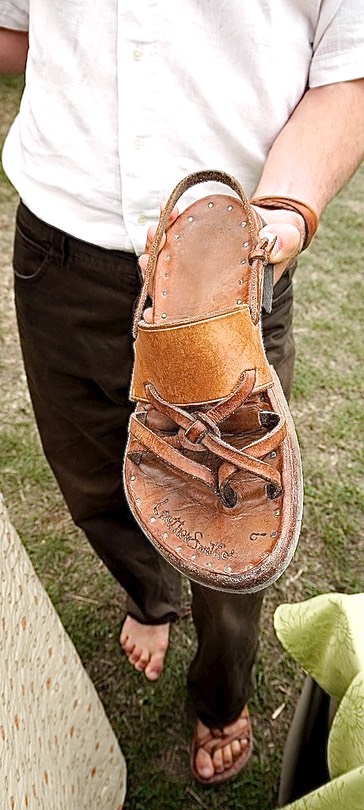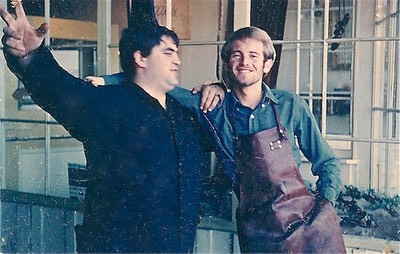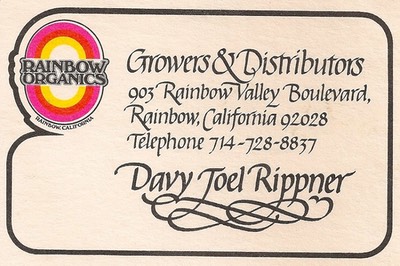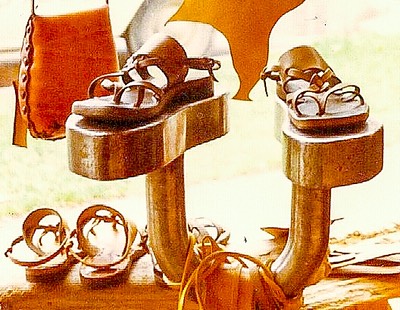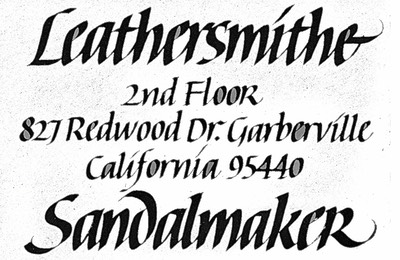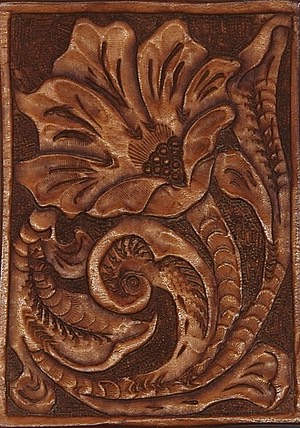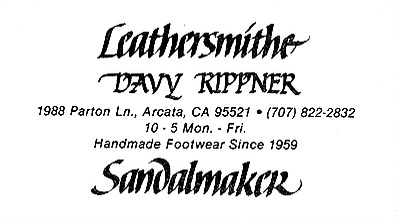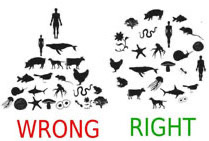Davy Joel Rippner Leathersmithe
leathersmithe@gmail.com
9886 Castle Road South Pender Island
British Columbia Canada V0N 2M3
Text only: 250 880 9191
Lifetime Guarantee on all saddle-stitching
I’ll repair any worn or broken Barbour's linen cord saddle-stitching on the wallets, bags & pouches that I make. Send or bring your purchase to me and I will return it to you in like-new condition.
Davy Joel Rippner

All the calligraphy on this site is Martin’s superb work.
He’s an old and cherished friend.

Martin Jackson was born in Sheffield, England, and emigrated to Canada in 1966. He has over 60 years of experience as a graphic designer and calligrapher, and for over 50 years has run his own design studio in Vancouver. As one of Canada’s foremost calligraphers he has lectured and taught across Canada, the US, Japan and Europe. Among his many commissions are pieces for their Royal Highnesses the Prince and Princess of Wales, and for the visit of Pope John Paul II in 1984. He also produced the calligraphy for the wedding reception of Bill Gates. When not working on his calligraphy he is an avid Nordic skier, and he collects and rears moths and butterflies.
How do you define creativity and apply it in your career?
"For me it is always the challenge of meeting the client's expectations. Usually I am presented with raw text, and working with this I have to create something which must not only be legible, but also something that is visually beautiful to amaze and delight them, and also on time and on budget. I must never forget that I am just offering my services, really no different from a plumber or a carpenter etc., I can’t be too ‘Artsy’!Where do you find your best creative inspiration?
"From studying early manuscripts. There is so much to be learned from the early scribes who produced such beautiful work using the most simple tools and materials.What’s the one creative advice or tip you wish you’d known as a young person?
"Not to get too carried away with trends and fads, they soon fade, it is not good to always be 'one of the herd’. If you have all the essential basic design skills it is better to develop your own style, it just takes time.Who would you like to hear speak at CreativeMornings? "Crispin Elsted of Barbarian Press.
If you had a magic wand, where would you be in five years? "Alive, and still able to do calligraphy!
Why is it important we don’t lose the skill of writing things by hand?
"Handwriting can be so beautiful, it is part of who we are, it can say so much about our personality.When you check your mail box there is something very special about finding an item addressed to you that has been written by hand, it makes an immediate contact somewhere deep within us. Part of this is because you realize that the person writing to you was also thinking only of you, and will have taken more care over the choice of words, and spelling etc. I can guarantee you will open this item first. No matter what font you use for an email it will never match the magic of hand writing, and how could anyone possibly think of writing a love letter using a computer!
It is not by accident that many of the other items in your mailbox will have used fonts that look like they are handwritten, hoping you will be fooled into thinking that “dear householder’ really is meant just for you, right?
Even those who say their handwriting is awful would be surprised at how much improved their writing would be if they used a Fountain Pen. The feel of a fountain pen in your fingers and seeing the flow of the ink and hearing the sound of the nib on good paper is quite sensuous. For handwriting one of the greatest disasters of all time was the introduction of the ballpoint pen, all thanks to Laszlo Biro who invented it, ever after we were all writing in a scrawly monoline 'style’.
How sad that so few people can find the time to 'put pen to paper’. I don’t think there is yet an 'app’ to solve this."
http://www.martinjacksoncalligraphy.com/
https://www.youtube.com/watch?v=zb_IzTXA_zE




How using sheepskin for legal
papers may have prevented fraud
Processing out the fat created a writing surface
easily marred by scratched-out words

This deed, involving ownership of land in Enfield, England, was written on parchment made from sheepskin and signed and sealed on January 15, 1499. Tampering with the ink on sheepskin would tear apart the layers of the skin, leaving a blemish on the parchment.
Fraudulent efforts to tweak legal documents in Great Britain may have been thwarted by the very parchment those documents were written on, a new study suggests.
Previous studies have shown that property deeds were written on a range of animal skins, such as goat, calf and sheep. But it turns out sheepskin was the parchment of choice, researchers report March 24 in Heritage Science. An analysis of proteins extracted from 645 samples from 477 British legal documents dating from the 16th to the 20th century shows that 622, or 96.4 percent, were made of sheepskin.
That popularity may be tied to low cost compared with other parchments, like vellum made from calfskin, as well as sheepskin’s fraud-busting powers.
To make parchment out of animal skin, the skins are submerged in lime, a white powdery caustic soda, which removes the fat. Sheepskin has more fat — accounting for 30 to 50 percent of its weight — than other animal skins. (Cattle skin, for instance, is 2 to 3 percent fat.) So its removal leaves bigger gaps between the skin’s other layers. Scraping ink from this parchment can detach these loose layers, marring the surface and revealing changes to it.
“We know so little about these documents, despite the fact that there are millions worldwide,” says study coauthor Sean Doherty, an archaeologist at the University of Exeter in England. Studies like these, Doherty says, “are transforming libraries into biomolecular archives,” which are allowing researchers to better understand animals, craft and trade over the past millennia.
Several 12th and 17th century documents describe sheepskin as useful in detecting changes to an original document, such as tampering with a property owner’s name. The new study adds to evidence that sheepskin helped to prevent fraudsters from pulling the wool over English officials’ eyes.
Special address for secret admirers
davy@leathersmithe.com

Begun December 2015
